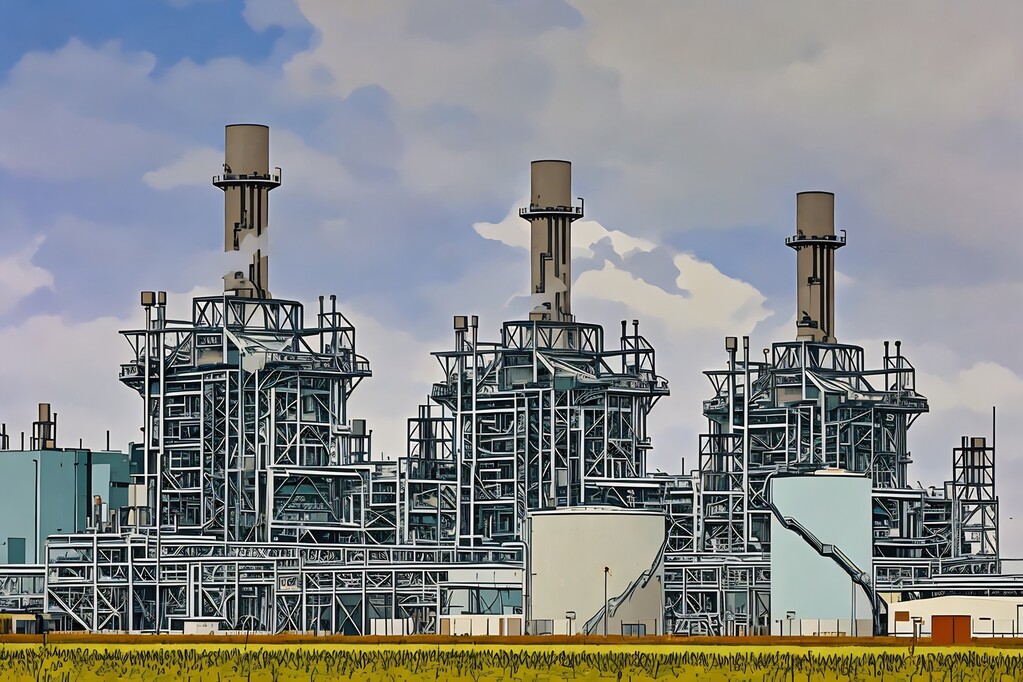As the U.S. moves towards a low-carbon future, the energy landscape is evolving rapidly, driven by the growth of renewable energy sources like wind and solar. Despite this transition, natural gas continues to play a significant role and is expected to remain an essential part of the energy mix for the foreseeable future. This Energy Brief explores the role of natural gas in the energy transition, examining its role as a reliable energy source, its ability to complement renewables, and the challenges it faces in a decarbonizing world.
Natural Gas as a Reliable Energy Source
Natural gas has long been a cornerstone of U.S. energy production, accounting for approximately 43% of electricity generation in 2023. Its reliability and flexibility make it indispensable, particularly when intermittent renewable sources, such as wind and solar, fail to meet demand. This characteristic makes natural gas an ideal “bridge” fuel in transitioning from coal to renewable energy. Unlike coal, natural gas produces fewer emissions, and its ability to quickly ramp up production provides a crucial buffer against the variability of renewable energy supply.
Gas-fired power plants, particularly those utilizing combined-cycle gas turbines (CCGT), have proven to be highly efficient, providing stable, dispatchable power to the grid. This flexibility is especially important in a system increasingly reliant on renewable energy, which can fluctuate due to weather conditions. In moments when solar or wind power generation dips—whether due to cloudy skies or calm weather—natural gas plants can quickly step in, ensuring that power demands are met.
Complementing Renewable Energy
As renewable energy becomes a more significant part of the U.S. energy portfolio, natural gas plays a crucial role in supporting grid stability. Solar and wind energy, while essential to reducing carbon emissions, are intermittent. The U.S. grid requires a dispatchable energy source to avoid disruptions in power supply during periods of low generation from renewables. Natural gas fills this gap, providing a backup solution when renewable energy generation falters. This has been particularly evident in regions such as New York and New England, where gas is expected to remain a key resource on peak-demand days, even as overall gas use declines.
Moreover, the existing infrastructure for natural gas, including pipelines and storage facilities, offers a cost-effective solution for ensuring a reliable energy supply. While renewable energy storage technologies, such as batteries, are advancing, they have yet to reach the scale or cost-effectiveness required to replace the need for natural gas entirely. In fact, experts suggest that large-scale battery storage would need to grow significantly before it could fully assume the role of gas in balancing supply and demand.
Challenges and the Path to Decarbonization
Natural gas faces significant challenges despite its benefits as the U.S. and the world strive to meet ambitious decarbonization goals. One of the primary criticisms of natural gas is its contribution to greenhouse gas emissions, particularly methane, a potent climate-warming gas. Although natural gas burns cleaner than coal, its production and transportation can result in methane leaks, which undermine the environmental benefits of switching from coal to gas.
Additionally, natural gas is not a long-term solution for achieving net-zero emissions. While it may serve as a bridge fuel in the short to medium term, continued reliance on natural gas beyond 2050 conflicts with global climate goals. Policymakers and industry leaders are increasingly focusing on reducing emissions from natural gas through technologies like carbon capture and storage (CCS) and improving the efficiency of gas infrastructure.
Another major challenge is the competition natural gas faces from increasingly affordable renewable energy sources. As solar and wind energy costs continue to decline, investment in natural gas may become less attractive. This trend could accelerate as governments and businesses ramp up their commitments to renewable energy development and climate-friendly policies.
The Future of Natural Gas in the U.S. Energy Mix
Natural gas will likely play a vital role in the U.S. energy system, especially as a reliable backup for renewable energy. In scenarios with high wind and solar power penetration, natural gas can act as a safeguard against variability, ensuring that the lights stay on during periods of low renewable output. However, its long-term future depends on the ability of the gas industry to mitigate emissions and integrate more sustainable practices, such as incorporating hydrogen and bioenergy.
Ultimately, while natural gas may see a gradual decline in its share of the energy mix, it will not disappear overnight. Its role as a flexible, dispatchable energy source ensures that it remains relevant as the U.S. works toward a cleaner, more sustainable energy future. The challenge moving forward will be balancing the immediate need for reliable energy with the imperative to decarbonize, ensuring that natural gas is used in a way that supports, rather than hinders, the transition to a net-zero world.
Conclusion
In conclusion, natural gas will remain a key player in the U.S. energy transition for the foreseeable future. Its ability to provide reliable, on-demand power makes it an essential complement to renewable energy sources like wind and solar. However, as the world moves toward decarbonization, the role of natural gas must evolve. Investments in reducing methane emissions, improving infrastructure, and integrating cleaner technologies will be critical in ensuring that natural gas remains a viable part of the energy mix while supporting broader climate goals. The future of natural gas, much like the energy transition itself, will require thoughtful planning and innovation to achieve a sustainable and resilient energy system.

